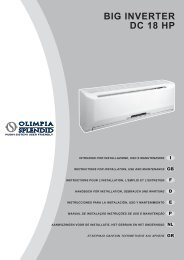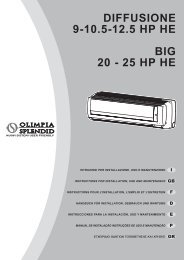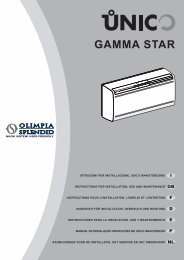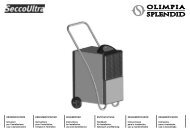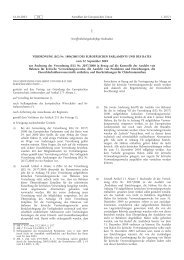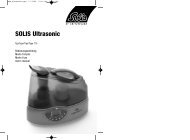MANUALE MULTIFLEXI INVERTER.pmd - KlimaShop!
MANUALE MULTIFLEXI INVERTER.pmd - KlimaShop!
MANUALE MULTIFLEXI INVERTER.pmd - KlimaShop!
You also want an ePaper? Increase the reach of your titles
YUMPU automatically turns print PDFs into web optimized ePapers that Google loves.
52<br />
2<br />
2.4.8<br />
I<br />
Allacciamento della linea di<br />
scarico condensa<br />
Collegare al tubo di scarico condensa<br />
dell’unità interna un tubo di<br />
drenaggio di appropriata lunghezza<br />
e bloccarlo con una fascetta.<br />
Farlo scorrere all’interno della<br />
canalina parallelamente ai tubi<br />
dell’impianto, fermandolo a questi<br />
con fascette, senza stringere troppo<br />
evitando di danneggiare l’isolante<br />
dei tubi e di strozzare il tubo<br />
di drenaggio.<br />
Fare defluire, dove possibile, il<br />
liquido di condensa direttamente<br />
in una gronda di scarico per acque<br />
bianche.<br />
Se il tubo di drenaggio viene<br />
imboccato in un sistema<br />
fognario, è necessario<br />
realizzare con il tubo stesso<br />
una curva per<br />
creare un sifone, in modo<br />
da evitare la diffusione di<br />
cattivi odori nell’ambiente.<br />
La curva di sifone non deve<br />
mai essere ad un livello inferiore<br />
ad 1,5 m dal filo inferiore<br />
dell’apparecchio.<br />
Se il drenaggio viene scaricato<br />
in un recipiente, questo<br />
non deve mai essere<br />
chiuso, per evitare<br />
contropressioni tali da<br />
compromettere l’operazione,<br />
ed il tubo stesso non<br />
deve mai raggiungere il livello<br />
del liquido in deposito.<br />
IMPORTANTE: verificare il<br />
corretto deflusso del liquido<br />
di condensa attraverso<br />
il relativo tubo versando,<br />
molto lentamente, circa 1/2<br />
litro di acqua nella<br />
vaschetta di raccolta dell’unità<br />
interna.<br />
GB F D<br />
Connection of condensation<br />
discharge line<br />
Connect the condensation drain<br />
pipe on the inside unit to a drain<br />
pipe of appropriate length and<br />
fasten with a hose clamp.<br />
Run the pipe inside the raceway<br />
parallel to the other system pipes<br />
and fastening it to them with hose<br />
clamps, not too tight so as not to<br />
damage the insulation on the<br />
pipes or kink the drain pipe.<br />
The condensation liquid should<br />
drain directly into a rainwater<br />
runoff gutter if possible.<br />
If the drain pipe discharges<br />
directly into the sewer system,<br />
it should be bent so as<br />
to create a trap, thus preventing<br />
any return of odour<br />
into the house.<br />
The trap bend should never<br />
be less than 1.5 m below the<br />
bottom of the appliance.<br />
If the drainage is discharged<br />
into a container,<br />
this should never be closed,<br />
so as to prevent any<br />
counterpressure that would<br />
interfere with discharge,<br />
and the pipe should never<br />
reach the level of the fluid<br />
in the container.<br />
IMPORTANT: check that the<br />
condensation liquid flows<br />
properly out of the pipe by<br />
pouring about 1/2 litre of<br />
water very slowly into the<br />
collection tank on the inside<br />
unit.<br />
Branchement de la<br />
conduite d’évacuation du<br />
condensat<br />
Relier au tuyau d’évacuation du<br />
condensat de l’unité intérieure un<br />
tuyau de drainage de la longueur<br />
appropriée et le bloquer par un<br />
collier. L’introduire à l’intérieur de<br />
la gaine parallèlement aux tuyaux<br />
de l’installation, en le bloquant à<br />
ceux-ci à l’aide de colliers, sans<br />
trop serrer évitant ainsi<br />
d’endommager l’isolant des tuyaux<br />
et d’écraser le tuyau de drainage.<br />
Faire évacuer, lorsque cela est<br />
possible, le liquide de<br />
condensation directement dans<br />
une gouttière d’évacuation pour<br />
les eaux de pluie.<br />
Si le tuyau de drainage est<br />
relié à un tout-à-l’égout, il<br />
faut réaliser avec ce même<br />
tuyau un coude pour créer<br />
un siphon, de manière à<br />
éviter l’émanation de mauvaises<br />
odeurs dans la<br />
pièce.<br />
Le coude de siphon ne doit<br />
jamais être à un niveau inférieur<br />
à 1,5 m du bord inférieur<br />
de l’appareil.<br />
Si le drainage est évacué<br />
dans un bac, celui-ci ne doit<br />
jamais être fermé, pour<br />
éviter des contre-pressions<br />
telles qui pourraient<br />
compromettre l’opération,<br />
et le tuyau même ne doit<br />
jamais arriver au niveau du<br />
liquide en dépôt.<br />
IMPORTANT: vérifier le correct<br />
écoulement du liquide<br />
de condensation à travers<br />
le tuyau correspondant en<br />
versant, très lentement,<br />
environ 1/2 litre d’eau dans<br />
le bac de récolte de l’unité<br />
intérieure.<br />
Anschluss der Kondenswasserableitung<br />
An die Kondenswasserableitung der<br />
Inneneinheit ist ein entsprechend<br />
langes Ablaufrohr anzuschließen,<br />
das mit einer Schelle zu befestigen<br />
ist. Dieses Rohr muss im Kabelkanal<br />
parallel zu den Rohren der Anlage<br />
verlegt und an diesen mit Schellen<br />
befestigt werden, wobei darauf zu<br />
achten ist, dass diese nicht zu fest<br />
angezogen werden, damit die<br />
Isolierung der Rohre nicht beschädigt<br />
und das Ablaufrohr nicht gequetscht<br />
wird. Das Kondenswasser sollte<br />
nach Möglichkeit direkt in eine<br />
Traufrinne abgeleitet werden.<br />
Wird das Kondenswasser in<br />
die Kanalisation abgeleitet,<br />
ist mit dem Rohr selbst - zur<br />
Vermeidung eines Eindringens<br />
von üblen Gerüchen in<br />
den Raum - ein Krümmer<br />
zur Bildung eines Siphons<br />
zu erstellen.<br />
Der Krümmer des Siphons<br />
darf sich niemals weniger<br />
als 1,5 m unterhalb der unteren<br />
Kante des Gerätes befinden.<br />
Wird das Kondenswasser in<br />
einen Behälter abgeleitet,<br />
darf dieser zur Vermeidung<br />
von Gegendrücken nie abgedeckt<br />
werden. Das Rohr<br />
selbst darf nie das Niveau<br />
des sich im Behälter ansammelnden<br />
Wassers erreichen.<br />
WICHTIG: Durch das entsprechende<br />
Rohr ist<br />
die einwandfreie<br />
Kondenswasserableitung zu<br />
überprüfen. Hierfür ist ca.<br />
ein 1/2 Liter Wasser sehr<br />
langsam in die Auffangschale<br />
der Inneneinheit zu<br />
gießen.



